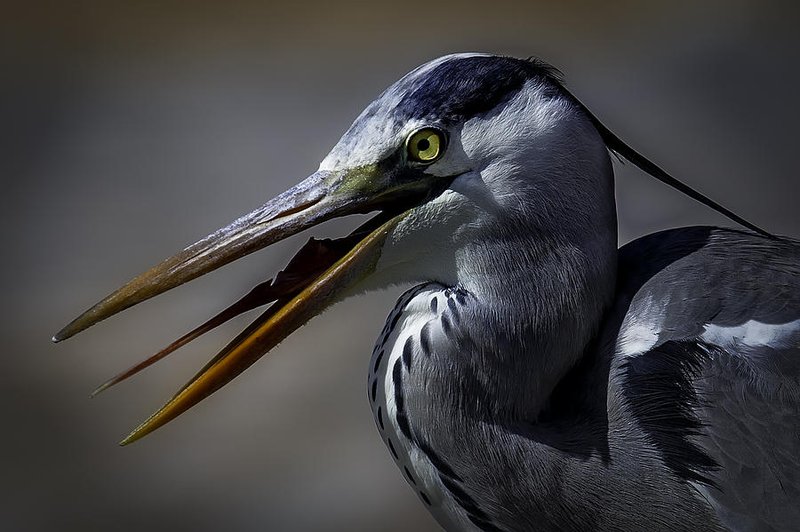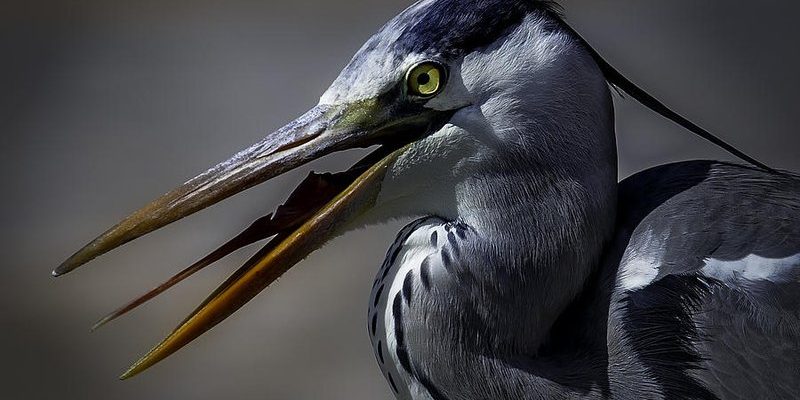
The Grey Heron is a fascinating bird that you might spot near lakes, rivers, and wetlands. With its long legs and elegant neck, this bird is often seen standing statue-like, waiting patiently for fish to swim by. It’s as if nature designed it with a built-in fishing rod! These birds have a unique charm that makes them stand out, not just because of their appearance, but also because of their behavior and habitat.
You might be wondering what makes the Grey Heron different from other birds. For starters, these herons are known for their distinctive grey and white plumage, which helps them blend in with their natural surroundings. They are skilled hunters, often using patience and precision to catch fish, frogs, and even small mammals. In this article, we’ll dive deeper into the world of the Grey Heron, exploring its characteristics, behavior, and more. So, grab a cup of coffee, and let’s get into it!
Physical Characteristics
The Grey Heron is a large bird, typically measuring between 80 to 100 cm in height. It has a striking wingspan that can reach up to 185 cm, which allows it to soar gracefully and cover great distances while searching for food. Its long legs are designed for wading through shallow waters, making it an excellent fisherman. The heron’s bill is long and pointed, perfect for snatching up slippery prey.
In terms of coloration, these birds sport a beautiful mixture of grey and white feathers. Their head is adorned with a black crown, and you’ll notice a distinctive, long neck that can extend and retract. The overall look of the Grey Heron is one of elegance and poise, which is often a striking sight against the backdrop of a serene waterway.
Interestingly, the plumage can show slight variations based on the individual and their habitat. Some might appear more faded or have a slightly different hue, especially if they spend more time in sunlit environments. This adaptability adds an extra layer of beauty to the species as they blend with their surroundings.
Habitat and Distribution
The Grey Heron is a versatile bird that thrives in a variety of habitats. You’ll commonly find them near freshwater bodies, such as lakes, ponds, rivers, and marshes. They prefer areas with abundant vegetation, providing both cover and hunting grounds. But don’t be surprised if you catch a glimpse of them in urban parks or even along coastal regions!
This bird’s distribution is quite impressive. It’s found across Europe, Asia, and parts of Africa, making it one of the most widely recognized herons globally. They are also migratory birds in some regions, moving to warmer areas during the winter months. This adaptability helps them maintain a stable population across various climates.
During the breeding season, Grey Herons build large nests in trees, often in colonies with other herons. They look for tall trees near water for safety and easy access to their food sources. This communal nesting allows them to benefit from the presence of each other, as it can deter potential predators.
Diet and Feeding Habits
The diet of the Grey Heron primarily consists of fish, making them one of nature’s savvy hunters. They are known for their exceptional fishing skills, often employing a technique where they remain motionless, waiting for fish to come close. When the time is right, they strike with lightning speed, using their long bill to catch their prey. It’s a process that takes both patience and precision!
In addition to fish, Grey Herons also consume other aquatic animals like frogs, crayfish, and even small birds or mammals when the opportunity arises. Their diet can vary based on the availability of food in their environment, showcasing their adaptability in the wild.
Interestingly, these birds also have a unique way of hunting. Some have been observed working together to herd fish into shallow waters, making it easier for them to catch their meals. This collaborative behavior highlights their intelligence and social nature, which can be quite captivating to observe.
Breeding and Nesting
Breeding season for Grey Herons typically occurs between late winter and early summer. They are monogamous during this time and often return to the same nesting site year after year. The male and female work together to build a large nest, usually made of twigs, reeds, and other available materials. This teamwork is essential for creating a safe environment for their young.
The female usually lays around three to six eggs, which both parents take turns incubating for about four to five weeks. Once the chicks hatch, they rely on their parents for food and protection. The parents are incredibly dedicated, often bringing food back to the nest to feed their growing brood. It’s a wonderful display of parental care!
As the young herons grow, they begin to develop their hunting skills, often practicing their fishing techniques as they mature. By the time they leave the nest, they are well-prepared to fend for themselves. However, they often stay close to their parents for some time, learning and perfecting their skills in a safe environment.
Conservation Status
The Grey Heron is currently classified as a species of “Least Concern” by the International Union for Conservation of Nature (IUCN). This means that, while they are not under immediate threat, their populations are still monitored. Habitat destruction and pollution can impact their numbers, so it’s crucial to maintain healthy wetland ecosystems.
In some areas, conservation efforts focus on preserving wetlands and promoting sustainable fishing practices. By protecting their habitats, we help ensure that Grey Herons can continue to thrive in their natural environments. It’s essential to recognize the role we play in maintaining biodiversity and supporting the wildlife around us.
Additionally, educating the public about the importance of these birds can foster a greater appreciation for them. When people understand the significance of the Grey Heron in ecosystems, it encourages them to take action in protecting their habitats and creating a healthier environment for all wildlife.
| Common Name: | Grey Heron |
| Scientific Name: | Ardea cinerea |
| Size: | 80-100 cm |
| Wingspan: | Up to 185 cm |
| Diet: | Fish, frogs, small mammals |
| Habitat: | Wetlands, lakes, rivers |
| Breeding Season: | Late winter to summer |
| Lifespan: | Up to 15 years in the wild |
Behavior and Social Structure
Grey Herons are known for their solitary behavior, usually hunting alone or in pairs. However, during breeding season, they form colonies that can host several nesting pairs. This social structure provides some safety in numbers, as the presence of multiple herons can deter predators. It’s fascinating to see how they balance between being solitary hunters and social birds!
In addition to their hunting strategies, Grey Herons have a variety of vocalizations. You might hear them making harsh squawking sounds or softer croaks, especially during nesting season. These calls are often used to communicate with each other, especially between mates or parents and their chicks. It’s like their own little language!
When not hunting, Grey Herons can often be seen preening their feathers or basking in the sun. Maintaining their plumage is essential for insulation and buoyancy while they fish. Watching a heron groom itself is a reminder of how much care these beautiful birds take with their appearance, which is a key part of their survival.
Interesting Facts
Did you know that the Grey Heron can fly at speeds of up to 30 miles per hour? That’s quite speedy for a bird, especially one that often looks so composed and still while hunting! Another fun fact is that these herons have excellent eyesight, allowing them to spot fish from high above as they soar through the sky.
Grey Herons also have a unique way of adapting to changing environments. In urban areas, they have learned to hunt in various settings, including parks and golf courses. Their flexibility shows just how resilient these birds can be when faced with challenges.
Lastly, these birds have been celebrated in various cultures and art forms throughout history. From ancient mythology to modern literature, the Grey Heron has captured the imagination of many. It serves as a symbol of grace and patience, reminding us of the beauty of nature and the creatures that inhabit it.
FAQ
What do Grey Herons eat?
Grey Herons primarily feed on fish, but their diet can also include frogs, small mammals, and crustaceans. They are skilled hunters and often catch these creatures by standing still and waiting for the right moment to strike with their long bills.
Where can I find Grey Herons?
These birds are commonly found near freshwater bodies like lakes, rivers, marshes, and even urban parks. They thrive in areas with abundant vegetation, which provides both cover and hunting grounds.
How do Grey Herons breed?
During the breeding season, which typically occurs from late winter to summer, Grey Herons build large nests in trees. They often return to the same nesting sites each year, and both parents share the responsibility of incubating the eggs and caring for the chicks.
Are Grey Herons migratory?
Yes, Grey Herons are migratory in some regions. They may move to warmer areas during the winter months to find better food sources. However, in many places, they are year-round residents.
What is the lifespan of a Grey Heron?
In the wild, Grey Herons can live up to 15 years. Their lifespan can be affected by various factors, including habitat quality and predation.
Do Grey Herons have any natural predators?
Young Grey Herons are vulnerable to predators like foxes, raccoons, and larger birds of prey. Adult herons face fewer threats, but they can still be targeted by eagles and other large raptors.
Can Grey Herons adapt to urban environments?
Yes, Grey Herons have shown remarkable adaptability to urban environments. They can often be seen hunting in parks and other green spaces, benefiting from the available water sources.
How can I help protect Grey Herons?
You can help protect Grey Herons by supporting wetland conservation efforts, reducing pollution, and promoting sustainable fishing practices. Educating others about the importance of these birds can also make a difference.
What are some threats to Grey Heron populations?
Some threats include habitat destruction due to urban development, pollution of waterways, and declining fish populations caused by overfishing. Protecting their habitats is crucial for keeping their populations stable.
How do Grey Herons communicate?
Grey Herons communicate using a variety of vocalizations, including squawks and croaks, especially during the breeding season. These calls help them maintain contact with their mates and chicks.
What is a group of Grey Herons called?
A group of Grey Herons is often referred to as a “heronry,” particularly when they are nesting. When they are gathered in feeding areas, they can also be called a “skewbald” of herons.

